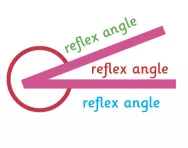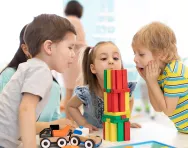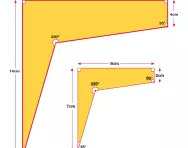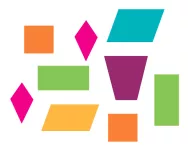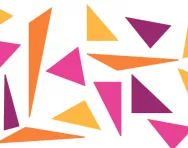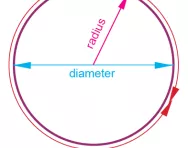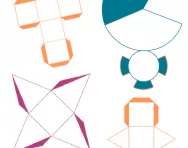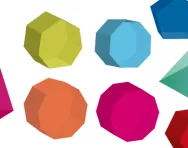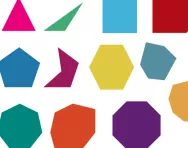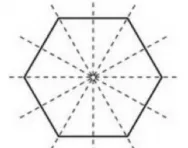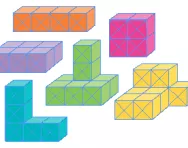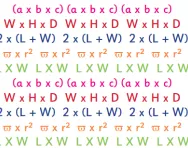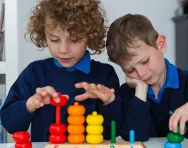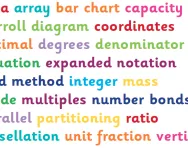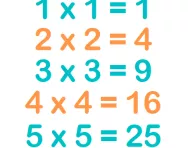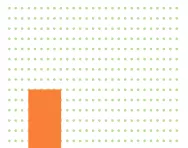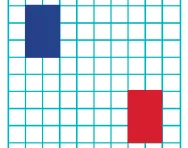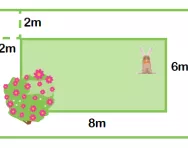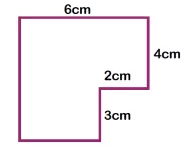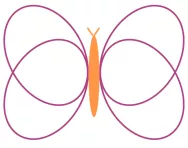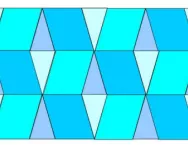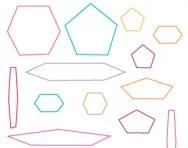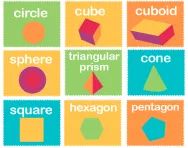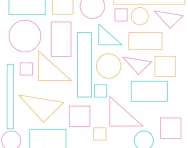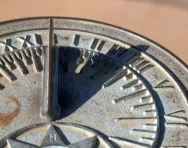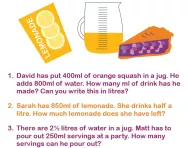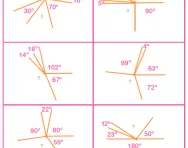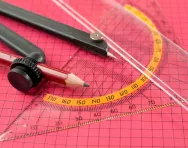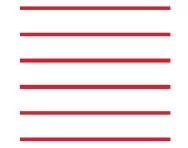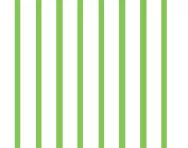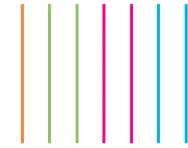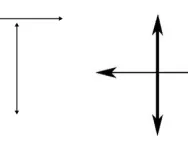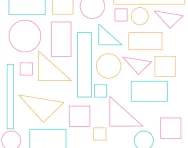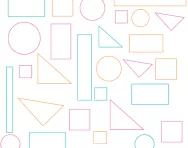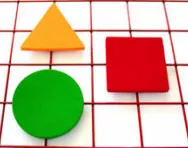Space and shape articles
What is a reflex angle?
An important geometry concept taught in Key Stage 2 is how to identify different types of angles, including reflex angles. Understanding angles is not just about being able to identify them; it's about recognising their real-world applications, from the hands on a clock to the turning of a wheel.
What your child learns in Nursery maths
Times tables and long division may be a way off, but the basic numeracy skills your child begins to learn in Nursery will lay the foundations for the years ahead.
Best shape and geometry apps for kids
Whether your child is just learning the difference between a square and a rectangle or solving complex algebraic problems, these apps will help them get to grips with shape and geometry.
What is scale factor?
Children learn about scale factor in Year 6 maths. Find out how to reinforce their understanding at home with our parents' guide to scale factor.
What is a quadrilateral?
Can you name the 2D shapes we classify as quadrilaterals? Find out how your child will learn about four-sided, 2D shapes in primary school and try some hands-on activities to reinforce their learning at home.
What are equilateral, scalene, isosceles and right-angled triangles?
Children learn to classify triangles as equilateral, isosceles, scalene or right-angled in KS2 geometry. Our guide for parents explains everything you need to know about triangles in primary school, from working out the area to calculating the internal angles.
What are the parts of a circle?
By the end of KS2 children are expected to be able to identify the parts of a circle (circumference, radius and diameter) and begin to use formulae to calculate a circle's perimeter and area. We explain what parents need to know about this aspect of primary-school geometry.
What are nets of shapes?
Can you make a 3D shape from its net? We explain how nets are used in the primary classroom to help children learn more about three-dimensional shapes and their properties in a hands-on, constructive way.
What are prisms and pyramids?
Prisms and pyramids explained for parents, including practical ways children work with 3D shapes in the classroom and learn about their properties.
What is a polygon?
Can you tell your hexagons from your heptagons? Your octagons from your decagons? With the help of educational experts, we explain how polygons are taught in primary school, with examples of regular and irregular versions of each multi-sided shape.
What are line symmetry, reflective symmetry and rotational symmetry?
Understand the forms of symmetry your child will be taught as part of the primary-school curriculum (line symmetry, reflective symmetry and rotational symmetry) and see how the concepts are applied in the KS2 classroom.
What is volume?
Volume and capacity are important concepts in primary maths, and your child will start learning about the amount of 3D space occupied by an object in Key Stage 1. Find out how you can support their learning at home, plus the relevant mathematical formulae, with our parents' guide to volume.
What is a formula?
Formulae help children to work out answers to mathematical problems. We explain which formulae your child will be taught in primary school, including how to calculate perimeter, area and volume, and how you can help your child feel confident using a formula in primary maths.
SATs revision: your KS1 SATs maths helper
KS1 SATs are no longer compulsory, but some schools may still administer them and numeracy SATs can seem a daunting task for Year 2 children. There are loads of practical, fun ways to help them consolidate their classroom learning and make mathematical concepts (from number bonds to 3D shapes) real and easy to understand. Teacher Alice Hart shares her tips.
Primary numeracy glossary for parents
From area to word problems, TheSchoolRun's primary-school numeracy glossary offers a complete guide to all the maths concepts children are taught in EYFS, KS1 and KS2. Brush up on your own mathematical skills, clear up homework confusion and understand exactly what your child is learning at school by reading our basic definitions (with links to more detailed explanations, teachers' tips and examples).
What are square numbers?
We explain what square numbers are and how children are taught to know square numbers plus the corresponding squares of multiples of 10. We also explain how knowledge of square numbers can help when it comes to working out the area of a square.
What is rotation of shapes?
We explain what the term rotation means in geometry, how primary-school children are taught to rotate shapes clockwise or anticlockwise or about the centre, and how to combine rotation with coordinates.
What is translation of shapes?
We explain what the term translation means in primary-school geometry and how children are taught to translate a shape on squared paper and to combine coordinates with translation of shapes.
What is area?
We explain what the term area means and how children are taught to calculate the area of a shape.
What is the perimeter?
We explain what the perimeter is and how teachers explain the concept to children in KS2, as well as showing the types of perimeter word problems children could be faced with.
What is symmetry?
We explain what symmetry is and how primary-school children are taught to find the line of symmetry and draw lines of symmetry on different shapes.
What are tessellating shapes?
We explain what tessellating shapes are and why tessellation may be taught in primary school as part of learning about 2D shapes.
What are coordinates?
We explain what coordinates are and how children are taught to read and plot coordinates on a grid.
What are regular and irregular shapes?
We explain what regular and irregular shapes are and suggest mnemonics to help children remember how many sides different shapes have. We also have examples of the types of questions primary-school children might be asked about shapes.
What are the properties of 2D and 3D shapes?
We explain what the properties of 2D and 3D shapes are, what faces, edges and vertices are and how children will describe 2D and 3D shapes in KS1 and KS2.
What are the names of 2D and 3D shapes?
We explain what the different 2D and 3D shapes are, when primary-school children are taught to name them and sort shapes according to their properties and when they learn to identify and draw their own nets of 3D shapes.
What are clockwise and anti-clockwise?
We explain what clockwise and anti-clockwise means and give examples of typical exercises your primary-school child might be presented with to test their understanding of rotation.
What are two-step and multi-step problems?
We explain what two-step and multi-step problems are and give examples of typical problems a child might be asked to solve in primary school (and how the answer can be worked out!).
What are degrees?
We explain what degrees are and how children are taught to use protractors to measure angles, as well as reviewing the different knowledge children acquire about angles throughout KS1 and KS2.
What are right, acute, obtuse and reflex angles?
We explain what right, acute, obtuse and reflex angles are and how children are taught about different angles through KS1 and KS2.
What is horizontal?
We explain how primary-school children are taught to recognise horizontal lines in shapes.
What is vertical?
We explain how primary-school children are taught to recognise vertical lines in shapes, and what you can to to support your child's understanding at home.
What is parallel?
We explain what parallel means and how children are taught about shapes throughout KS1 and KS2.
What is perpendicular?
We explain what perpendicular means and how children are taught angles throughout KS1 and KS2.
What is diagonal?
We explain what diagonal means in geometry and why it is important that children understand this term when learning about 2D shapes in primary school.
Teachers' tricks for shape, space and geometry
Throughout primary school children learn about the properties of the shapes in the world around them (primary geometry, in other words). Phoebe Doyle offers some insiders’ tips on helping them master shape and space maths targets.
Help your child learn about shapes
Learning about shapes and geometry plays a major part in your child's numeracy education across the Key Stages. Here are some tips to help them get a head start.
